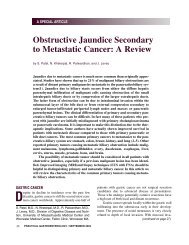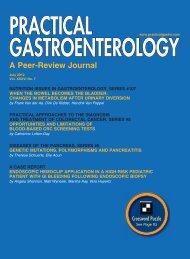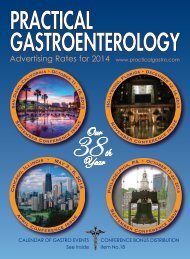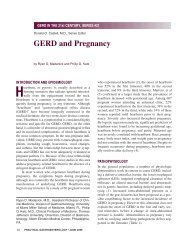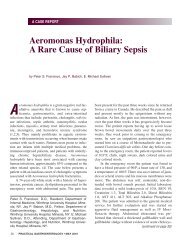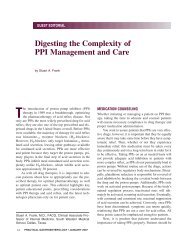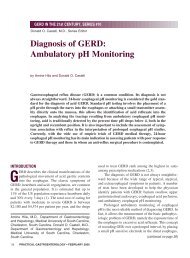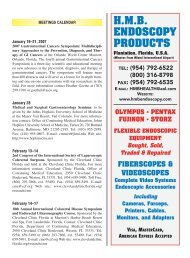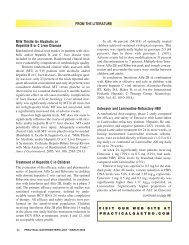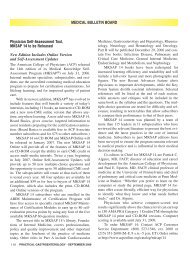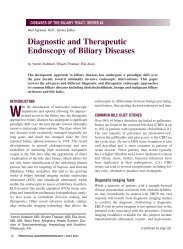Lactose Intolerance - Practical Gastroenterology
Lactose Intolerance - Practical Gastroenterology
Lactose Intolerance - Practical Gastroenterology
Create successful ePaper yourself
Turn your PDF publications into a flip-book with our unique Google optimized e-Paper software.
NUTRITION SUPPORT IN GASTROENTEROLOGY, SERIES #2<br />
Series Editor: Carol Rees Parrish, RD, MS, CNSD<br />
<strong>Lactose</strong> <strong>Intolerance</strong>:<br />
Considerations for the Clinician<br />
Stacey McCray<br />
An estimated 30% of Americans and approximately 65%–75% of people worldwide<br />
have decreased intestinal lactase levels, which may lead to lactose intolerance and difficulty<br />
digesting dairy products. The primary goals for treatment of lactose intolerance<br />
include symptom relief and ensuring adequate nutritional status. Many patients<br />
who wish to continue to consume dairy products (lactose) can do so by adjusting the<br />
type, amount and timing of intake. Patients with lactose intolerance are at risk for<br />
inadequate intake of calcium and vitamin D, which ultimately leads to an increased<br />
risk of osteoporosis. The intent of this article is to provide practical guidelines for<br />
working with patients who are lactose intolerant and to answer some common questions<br />
that may arise.<br />
INTRODUCTION<br />
L<br />
actose malabsorption occurs when lactose, the<br />
primary sugar in dairy products, is not completely<br />
digested and absorbed in the small bowel. Lactase,<br />
the enzyme required to hydrolyze lactose for<br />
intestinal absorption, is found primarily in tips of the<br />
villi in the jejunum (1). If lactase activity is decreased<br />
as a result of primary deficiency, altered anatomy, or<br />
an underlying disease process, malabsorption of lactose<br />
may occur. When unabsorbed lactose reaches the<br />
colon, colonic bacteria use this substrate for fermentation,<br />
producing gas and short chain fatty acids. The<br />
Stacey McCray, RD, Consulting Dietitian, Charlottesville,<br />
Virginia<br />
unabsorbed lactose also affects osmolality, causing<br />
water to be drawn into the bowel and accelerating the<br />
intestinal transit time (1). The symptoms of lactose<br />
intolerance may include bloating, diarrhea, flatulence,<br />
abdominal pain, distention and cramping.<br />
The most common cause of lactose malabsorption<br />
and lactose intolerance is a natural decrease in intestinal<br />
lactase levels, known as primary adult hypolactasia<br />
(2) or lactase non-persistence (1). This decrease<br />
usually begins during childhood or adolescence and is<br />
very common among adults (1,3). It is estimated that<br />
30% of Americans (4) and 65%–75% (1,4) of people<br />
worldwide have low lactase levels. Human congenital<br />
lactase deficiency is an extremely rare condition<br />
where there is a complete lack of lactase activity (1).<br />
PRACTICAL GASTROENTEROLOGY • FEBRUARY 2003 21
<strong>Lactose</strong> <strong>Intolerance</strong>: Considerations for the Clinician<br />
NUTRITION SUPPORT IN GASTROENTEROLOGY, SERIES #2<br />
<strong>Lactose</strong> malabsorption may also be a secondary<br />
problem due to small bowel disease or other disorders<br />
which cause inflammation or flattening of the villi (5).<br />
Malabsorption in such cases is thought to be primarily<br />
due to decreased lactase production, although other<br />
factors may also play a role in tolerance (6). Secondary<br />
lactase deficiency may be transient and often resolves<br />
once the underlying condition improves (7).<br />
A complete review of the epidemiology, pathophysiology<br />
and other details of lactose malabsorption<br />
and lactose intolerance are available elsewhere (1,2).<br />
The intent of this article is to provide practical information<br />
for dealing with the clinical aspects of lactose<br />
intolerance.<br />
DIAGNOSING LACTOSE INTOLERANCE—<br />
THE HYDROGEN BREATH TEST<br />
Currently, the most common test used to diagnose lactose<br />
malabsorption is the lactose hydrogen breath test.<br />
During the test, a patient is given a large dose of lactose,<br />
after which hydrogen levels in the breath are<br />
measured at regular intervals. A rise in hydrogen<br />
breath levels (>20 ppm over baseline) theoretically<br />
indicates increased gas production due to malabsorbed<br />
lactose reaching the large intestine. In addition to the<br />
physician interpretation fee, the cost of the test is in the<br />
range of $180.<br />
There are several things to remember about the<br />
hydrogen breath test. First, it diagnoses lactose malabsorption.<br />
This may or may not translate into lactose<br />
intolerance. Numerous studies have shown a disconnect<br />
between results of the hydrogen breath test and<br />
clinical symptoms (8–13). The test uses a large amount<br />
of lactose, usually 50 grams (equivalent to 4 glasses of<br />
milk), and is given in a form which is often the most<br />
d i fficult for patients to tolerate (lactose in water) (1).<br />
Many adult patients will have trouble digesting this<br />
amount of lactose regardless of how they tolerate<br />
smaller amounts in a normal, regular diet. Keep in mind<br />
also, that this dose of lactose will likely cause significant<br />
discomfort to a patient with lactose intolerance.<br />
Such patients may not agree the test is simple or easy.<br />
False negative results may be caused by an absence<br />
of hydrogen producing bacteria, recent use of antibiotics,<br />
or recent high colonic enema (2). Certain factors<br />
may increase hydrogen production regardless of lactase<br />
status; these include sleep, exercise, use of aspirin, or<br />
smoking (2). Bacterial overgrowth of the small bowel<br />
may also make interpretation of this test more diff i c u l t .<br />
An earlier rise in hydrogen production would be<br />
expected in this setting (small bowel versus colonic<br />
production). Unfortunately, many conditions that are<br />
associated with bacterial overgrowth may also aff e c t<br />
intestinal motility, further clouding the issue. (Look for<br />
more on bacterial overgrowth in an upcoming issue.)<br />
Given the above factors, as well as the expense of<br />
diagnostic testing, a two-week empiric trial of a low<br />
lactose (
<strong>Lactose</strong> <strong>Intolerance</strong>: Considerations for the Clinician<br />
NUTRITION SUPPORT IN GASTROENTEROLOGY, SERIES #2<br />
(continued from page 22)<br />
Table 1<br />
<strong>Lactose</strong> Content of Common Dairy Products<br />
<strong>Lactose</strong><br />
Product Serving Size Content (g)<br />
Milk (whole, lowfat,<br />
or nonfat) 1 cup 11<br />
Buttermilk 1 cup 10<br />
Acidophilous milk 1 cup 11<br />
Yogurt, whole milk 1 cup 10–12<br />
Yogurt, low fat 1 cup 5–19<br />
Cheese (such as cheddar,<br />
American, Swiss, parmesan) 1 oz 0.4–3<br />
Cottage cheese 1/2 cup 3–4<br />
Ice Cream 1/2 cup 5–6<br />
Sherbet, orange 1/2 cup 2<br />
Whipped cream 1/2 cup 3<br />
Sour cream 1/2 cup 4<br />
Cream cheese 1 oz 1<br />
Half & Half/cream 2 tbsp 1<br />
Butter/margarine 1 tbsp Trace<br />
Table 2<br />
<strong>Lactose</strong> Content of Common Liquid Nutritional Supplements<br />
Grams of<br />
Product Serving Size <strong>Lactose</strong> (grams)<br />
Ensure ® drink 1 can 0<br />
Ensure ® powder<br />
1/2 cup powder<br />
with 3/4 cup water 0<br />
Boost ® drink 1 can 0<br />
Ensure ® bars 1 bar 2–3<br />
Ensure ® pudding 4 oz serving 5<br />
Boost ® pudding 4 oz serving 0<br />
Carnation ® Instant 1 packet of powder 8<br />
Breakfast Powder (vanilla) 1 packet mixed with 8 oz milk 19<br />
Carnation ® Instant Breakfast<br />
Ready to Drink varieties 1 can 9–13<br />
Slim-fast ® powder 1 scoop mixed with 8 oz milk 15–16<br />
Slim-fast ® Ready to Drink varieties 1 can 10–12<br />
Slimfast ® water-mixable powder<br />
with soy protein 2 scoops mixed with 8 oz water 0<br />
Slim-fast ® Fruit Juice Powder 1 scoop mixed with 8 oz juice 0<br />
Slim-fast ® Ready-to-Drink Fruit<br />
Juice Shakes with soy protein 1 can 0<br />
pain relievers, anti-diarrheal agents and multivitamin/mineral<br />
supplements contain lactose.<br />
Many prescription drugs also contain lactose.<br />
This may be an issue for patients who are<br />
extremely intolerant and it may be something<br />
to look for in patients who do not completely<br />
respond to a lactose free diet alone.<br />
DIETARY MANAGEMENT<br />
<strong>Lactose</strong> intolerance appears to be dose dependent.<br />
By adjusting the type and amount<br />
ingested, many patients with lactose intolerance<br />
can include dairy products in their diet.<br />
Suarez, et al. (4) showed that patients with lactose<br />
maldigestion could tolerate a diet containing<br />
1300 mg of calcium from dairy products<br />
each day. Many patients can tolerate small<br />
amounts of dairy products throughout the day,<br />
such as 1/2–1 cup of milk at a time for a total<br />
of up to two cups per day (3,4).<br />
Some dairy foods are better<br />
tolerated than others by<br />
patients with lactose intolerance.<br />
Hard cheeses have a relatively<br />
low lactose content<br />
and are often tolerated. Cultured<br />
yogurt is generally very<br />
well tolerated, even by lactose<br />
malabsorbers (1,15). This is<br />
likely, at least in part, due to<br />
the bacteria contained in cultured<br />
yogurt, which continue<br />
to digest lactose both in storage<br />
and after ingestion in the<br />
small bowel. Acidophilous<br />
milk, however, is generally no<br />
better tolerated than regular<br />
milk (1,15,16). The lactobacillus<br />
bacteria do not<br />
hydrolyze lactose like the<br />
bacteria in yogurt. Buttermilk<br />
has also been found to be no<br />
better tolerated than regular<br />
milk (15,16).<br />
(continued on page 28)<br />
24<br />
PRACTICAL GASTROENTEROLOGY • FEBRUARY 2003
<strong>Lactose</strong> <strong>Intolerance</strong>: Considerations for the Clinician<br />
NUTRITION SUPPORT IN GASTROENTEROLOGY, SERIES #2<br />
(continued from page 24)<br />
Table 3<br />
Lactase Enzyme Replacement Supplements<br />
Recommended Lactaid ® Store Brand Cost per year<br />
Type / Strength Dose (cost per dose) (cost per dose) (based on 2 doses/day)<br />
Regular (3000 lactase units) 3 caplets $0.30 $0.23<br />
Extra (4500 lactase units) 2 caplets $0.31 $0.24 $102.00–$227.00<br />
Ultra (9000 lactase units) 1 caplet $0.25 $0.14<br />
Other factors may also affect tolerance of lactosecontaining<br />
foods. Ingesting dairy products with a meal<br />
seems to improve tolerance (1). This is thought to be<br />
due to the effect of gastric emptying and slower delivery<br />
of the lactose to the small bowel. Consuming foods<br />
with a higher fat content (such as ice cream) may also<br />
produce a similar effect, although this has not been<br />
proven (1).<br />
COLONIC ADAPTATION<br />
It has been shown that some patients may have<br />
improved tolerance of lactose over time if lactose-containing<br />
foods are provided slowly and consistently (17).<br />
This does not mean the small bowel adapts to produce<br />
more lactase; the human small bowel does not produce<br />
more lactase in response to increased consumption<br />
( 11). This "adaptation" most likely occurs in the colon.<br />
Over time, the colonic flora may adapt to the lactose<br />
load, resulting in less gas production. This, along with<br />
adaptations in motility and pH, may decrease or eliminate<br />
the symptoms of lactose intolerance. (5,11 ) .<br />
SUPPLEMENTAL LACTASE ENZYMES<br />
AND OTHER PRODUCTS<br />
Supplemental lactase enzymes are available for<br />
patients who do not tolerate lactose but wish to continue<br />
to consume dairy products (see Table 3 for information<br />
on common types and brands). These are most<br />
readily available in caplet or chewable tablet forms.<br />
Patients may wish to try the suggestions discussed<br />
above before adding the expense of lactase enzyme<br />
supplements. Some dairy products that are more easily<br />
tolerated (hard cheese, yogurt) may not require supplemental<br />
enzymes. In addition, most lactase supplements<br />
recommend a dose of 9000 lactase units be<br />
taken with dairy products. This dose of enzyme may<br />
not be necessary for all patients; patients may wish to<br />
start with a lower dose initially and titrate up based on<br />
symptoms.<br />
Liquid enzyme drops that can be added to milk no<br />
longer appear to be readily available. They may, however,<br />
still be available in specialty stores and online.<br />
Instead, most grocery stores carry ready to drink 100%<br />
lactose reduced milk in the dairy section. It is generally<br />
available in fat free, 1%, 2%, and whole milk varieties.<br />
The cost of lactase treated milk is approximately<br />
$0.39 per cup versus $0.17–0.29 per cup of regular<br />
milk. Vitamite ® 100, also found in many grocery<br />
stores, is a non-dairy, lactose free milk alternative.<br />
Vitamite ® 100 contains calcium and vitamin D in levels<br />
similar to milk; however, the protein content is<br />
lower (3 grams versus 9 grams per 8 oz serving). The<br />
cost is similar to that of lactose reduced milk.<br />
CALCIUM INTAKE<br />
Several studies have shown that patients with lactose<br />
intolerance have significantly less calcium intake than<br />
those who tolerate lactose (8,9,18). In two of these<br />
studies, patients who were lactose intolerant had average<br />
calcium intake of only 300 mg (9) to 388 mg/day<br />
(18). This is only 20%–40% of the recommended calcium<br />
intake depending on gender, age and other factors.<br />
Table 4 shows the National Institutes of Health<br />
recommendations for optimal calcium intake (19);<br />
Table 5 shows the Adequate Intake (AI) level for calcium<br />
as set in the Dietary Reference Intakes (DRIs)<br />
(continued on page 31)<br />
28<br />
PRACTICAL GASTROENTEROLOGY • FEBRUARY 2003
<strong>Lactose</strong> <strong>Intolerance</strong>: Considerations for the Clinician<br />
NUTRITION SUPPORT IN GASTROENTEROLOGY, SERIES #2<br />
(continued from page 28)<br />
Table 4<br />
National Institutes of Health Recommendations<br />
for Optimal Calcium Intake (19)<br />
Age and other considerations<br />
Recommended<br />
calcium intake<br />
(mg/day)<br />
Adolescents and young adults<br />
(11–24 yrs) 1200–1500<br />
Women (25–50 yrs) 1000<br />
Pregnant or lactating women 1200–1500<br />
Postmenopausal women (25–65 yrs)<br />
on estrogen therapy 1000<br />
Postmenopausal women (25–66 yrs)<br />
not on estrogen therapy 1500<br />
Men (25–65 yrs) 1000<br />
Men and women over 65 yrs 1500<br />
(20). The DRIs were published by the Food and Nutrition<br />
Board (FNB) and replace the Recommended<br />
Dietary Allowances (RDA). Adequate intake (AI) levels,<br />
such as those for calcium and vitamin D (see<br />
Table 5<br />
Adequate Intake (AI) Levels for Calcium Based on<br />
1997 Dietary Reference Intakes (DRIs) (20)<br />
Age (Both men and women)<br />
AI for calcium<br />
(mg/day)<br />
19–50 years 1000<br />
> 50 years 1200<br />
Tables 5 and 8), are based on the average nutrient<br />
intake of healthy groups of people.<br />
Decreased calcium intake translates into decreased<br />
bone mass and higher risk for osteoporosis. Studies<br />
have shown that patients with lactose intolerance had<br />
significantly lower bone mineral density (BMD) than<br />
those who tolerate lactose (6,8). Therefore, the calcium<br />
intake of all patients with lactose intolerance<br />
should be evaluated (see Table 6). Patients with lactose<br />
intolerance absorb calcium under normal mechanisms,<br />
including calcium from dairy products (20).<br />
Table 6<br />
Approximate Calcium Content of Foods and Other Products<br />
Approximate<br />
Food Serving Size Calcium Content (mg)*<br />
Milk 1 cup 285–300<br />
Cheese 1 oz 175–275<br />
Yogurt 1 cup 275–450<br />
Ice cream 1/2 cup 90–135<br />
Almonds 1 oz 75<br />
Broccoli 1 cup 90–180<br />
Greens (turnip, collard)/kale 1/2 cup 90–180<br />
Salmon, canned, with bones 3 oz 165–285<br />
Sardines, canned, with bones 3 oz 370<br />
Tofu, firm 1/2 cup 155–260<br />
Calcium fortified orange juice 1 cup 290<br />
Fortified cereals 1 serving varies widely by brand<br />
Vitamite ® 100 1 cup 300<br />
Multivitamin with minerals 1 dose 0–210<br />
*Calcium content of foods may vary based on brand, ingredients, etc. Patients<br />
should read labels to determine the actual calcium content of a certain food.<br />
CALCIUM AND CALCIUM<br />
SUPPLEMENTS<br />
Patients who are unable to consume<br />
adequate calcium through the diet may<br />
require calcium supplementation. The<br />
first step is to assess how much calcium<br />
a patient is actually receiving in the<br />
diet, then make recommendations for<br />
supplemental calcium based on<br />
requirements (see Tables 4, 5, 6).<br />
Numerous brands of calcium supplements<br />
are currently available (see<br />
Table 7 for common brands). Calcium<br />
carbonate and calcium citrate are the<br />
most common forms. Some studies<br />
have shown that calcium citrate is better<br />
absorbed than calcium carbonate<br />
(20–22), however, a recent study<br />
showed equal absorption when vitamin<br />
D was also supplemented (23). For<br />
patients with achlorhydria, calcium<br />
(continued on page 36)<br />
PRACTICAL GASTROENTEROLOGY • FEBRUARY 2003 31
<strong>Lactose</strong> <strong>Intolerance</strong>: Considerations for the Clinician<br />
NUTRITION SUPPORT IN GASTROENTEROLOGY, SERIES #2<br />
(continued from page 31)<br />
Table 7<br />
Common Calcium Supplements<br />
Elemental Calcium Approximate<br />
Brand (mg) per tablet cost per tablet Comments<br />
Calcium Carbonate: 40% elemental calcium (25)<br />
Tums ® 200 $.02<br />
Extra Strength Tums ® 300 $.04<br />
Oscal ® 500 500 $.10 • Also available with 200 IU vitamin D<br />
• Also available in 250 mg dose<br />
Caltrate ® 600 Plus 600 $.11 • Contains 200 IU vitamin D plus additional minerals<br />
Viactiv‚ ® 500 $.10 • Contains 100 IU vitamin D and 40 mcg vitamin K<br />
• Contains 70 years 600<br />
source of vitamin D in the diet. Although some vitamin<br />
D is derived from sunlight, some vitamin D in the<br />
diet is also important in maintaining adequate levels<br />
(20). Ultraviolet radiation in northern areas may not<br />
allow for adequate vitamin D synthesis (3). Moreover,<br />
the elderly (>65 yrs) may lose some of their capacity<br />
to synthesize vitamin D from sunlight, in addition to<br />
often decreased exposure (20). Therefore, many<br />
patients may benefit from a calcium supplement that<br />
also includes vitamin D. See Table 8 for vitamin D recommendations<br />
based on the DRIs (20).<br />
carbonate taken with meals (20) or calcium citrate (24)<br />
may be better absorbed. Optimal absorption of calcium<br />
occurs with doses of
<strong>Lactose</strong> <strong>Intolerance</strong>: Considerations for the Clinician<br />
NUTRITION SUPPORT IN GASTROENTEROLOGY, SERIES #2<br />
(continued from page 36)<br />
Table 9<br />
Summary Tips for Managing <strong>Lactose</strong> <strong>Intolerance</strong><br />
• If a patient wishes to continue to consume lactose<br />
containing foods, try the following:<br />
– Smaller doses of lactose throughout the day<br />
– More easily tolerated dairy products (such as<br />
cultured yogurt, hard cheese)<br />
– Consumption of lactose containing foods with<br />
a meal<br />
– Trial of lactase enzymes, if needed<br />
• Ensure adequate calcium intake<br />
– Consider current intake of calcium from food and<br />
supplements when making recommendations for<br />
additional calcium<br />
– Recommend supplements in doses of
<strong>Lactose</strong> <strong>Intolerance</strong>: Considerations for the Clinician<br />
NUTRITION SUPPORT IN GASTROENTEROLOGY, SERIES #2<br />
erance, and milk intolerance. Am J Clin Nutr, 1993; 57:399-401.<br />
13. Shaw AD, Davies GJ. <strong>Lactose</strong> intolerance: Problems in diagnosis<br />
and treatment. J Clin Gastroenterol, 1999;28:208-216.<br />
14. Albert MB, Callaway CW. Clinical Nutrition for the House Offi -<br />
cer. Baltimore, MD: Williams and Wilkens; 1992.<br />
15. Savaiano DA, AbouElAnouar A, Smith DE, Levitt MD. <strong>Lactose</strong><br />
malabsorption from yogurt, pasteurized yogurt, sweet acidophilus<br />
milk, and cultured milk in lactase-deficient individuals. Am J Clin<br />
Nutr, 1984;40:1219-1223.<br />
16. Liebman B: <strong>Lactose</strong>. Truth or intolerances. Nutrition Action<br />
Healthletter, 1991:8-9.<br />
1 7 . Pribila BA, Hertzler SR, Martin BR, Weaver CM, Savaiano DA.<br />
Improved lactose digestion and intolerance among African-American<br />
girls fed a dairy-rich diet. J Amer Diet Assoc, 2 0 0 0 ; 1 0 0 : 5 2 4 - 5 2 8 .<br />
18. Buchowski MS, Semenya J, Johnson A. Dietary calcium intake in<br />
lactose maldigesting intolerant and tolerant African-American<br />
women. J Am Coll Nutr, 2002;21:47-54.<br />
19. Optimal Calcium Intake. NIH Consens Statement Online 1994<br />
June 6-8; 12(4):1-31.<br />
20. The Institute of Medicine. Dietary Reference Intakes (DRI) for<br />
Calcium, Phosporous, Magnesium, Vitamin D and Fluoride.<br />
Washington DC: National Academy Press;1997.<br />
21. Nicar MJ, Pak CYC. Calcium bioavailability from calcium carbonate<br />
and calcium citrate. J Clin Endocrinol Metab, 1985;61:<br />
391-393.<br />
22. Hughes BD, Dallal GE, Krall KA, et al. A controlled trial of the<br />
effect of calcium supplementation on bone density in postmenopausal<br />
women. N Engl J Med, 1990; 323:878-883.<br />
23. Heaney RP, Dowell MS, Bierman J, Hale CA, Bendich A.<br />
Absorbability and Cost Effectiveness in Calcium Supplementation.<br />
J Am Coll Nutr, 2001;20:239-246.<br />
24. Keller JL, Lanou AJ, Barnard ND. The consumer cost of calcium<br />
from food and supplements. J Amer Diet Assoc, 2002;102:1669-<br />
1671.<br />
25. Medline Plus Health Information. Calcium Supplements (Systemic).<br />
Available at: http://www.nlm.nih.gov/medlineplus/druginfo/uspdi/202108.html.<br />
Accessed December 10, 2003.<br />
26. Mishkin B, Yalovsky M, Mishkin S. Increased prevalence of lactose<br />
malabsorption in Crohn's disease patients at low risk for lactose<br />
malabsorption based on ethnic origin. Am J Gastroenterol,<br />
1997;92:1148-1153.<br />
27. Mishkin S: Nutritional Issues in Inflammatory Bowel Disease.<br />
Nutrition & the MD, 2000; 26:1-4.<br />
28. Bernstein CN, et al. Milk product tolerance in adults with ulcerative<br />
colitis (UC). American Gastroenterological Association<br />
Digestive Disease Week Abstract Syllabus, Boston, MA. American<br />
Gastroenterological Association; 1993, p. A-542.<br />
29. The Crohn's and Colitis Foundation of America. Diet, Nutrition<br />
and Fitness page. Available at: http://www.ccfa.org/medcentral/<br />
library/diet/eat.htm. Accessed November 23, 2002.<br />
P R A C T I C A L G A S T R O E N T E R O L O G Y<br />
PRACTICAL<br />
GASTROENTEROLOGY<br />
<strong>Practical</strong> <strong>Gastroenterology</strong> reprints are valuable,<br />
authoritative, and informative. Special rates are<br />
available for quantities of 100 or more.<br />
For further details on rates or to place an order:<br />
<strong>Practical</strong> <strong>Gastroenterology</strong><br />
Shugar Publishing<br />
9 9 B Main Street<br />
Westhampton Beach, NY 11978<br />
Phone: 631-288-4404<br />
Fax: 631-288-4435<br />
There isn’t a physician<br />
who hasn’t at least<br />
one “Case to Remember”<br />
in his career.<br />
Share that case with your<br />
fellow gastroenterologists.<br />
Send it to Editor:<br />
<strong>Practical</strong> <strong>Gastroenterology</strong>,<br />
99B Main Street<br />
Westhampton Beach, NY 11978.<br />
Include any appropriate illustrations.<br />
Also, include a photo of yourself.<br />
PRACTICAL GASTROENTEROLOGY • FEBRUARY 2003 39



